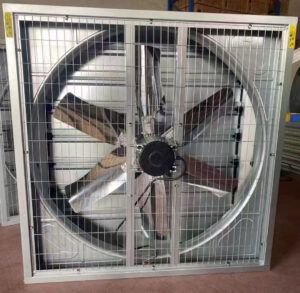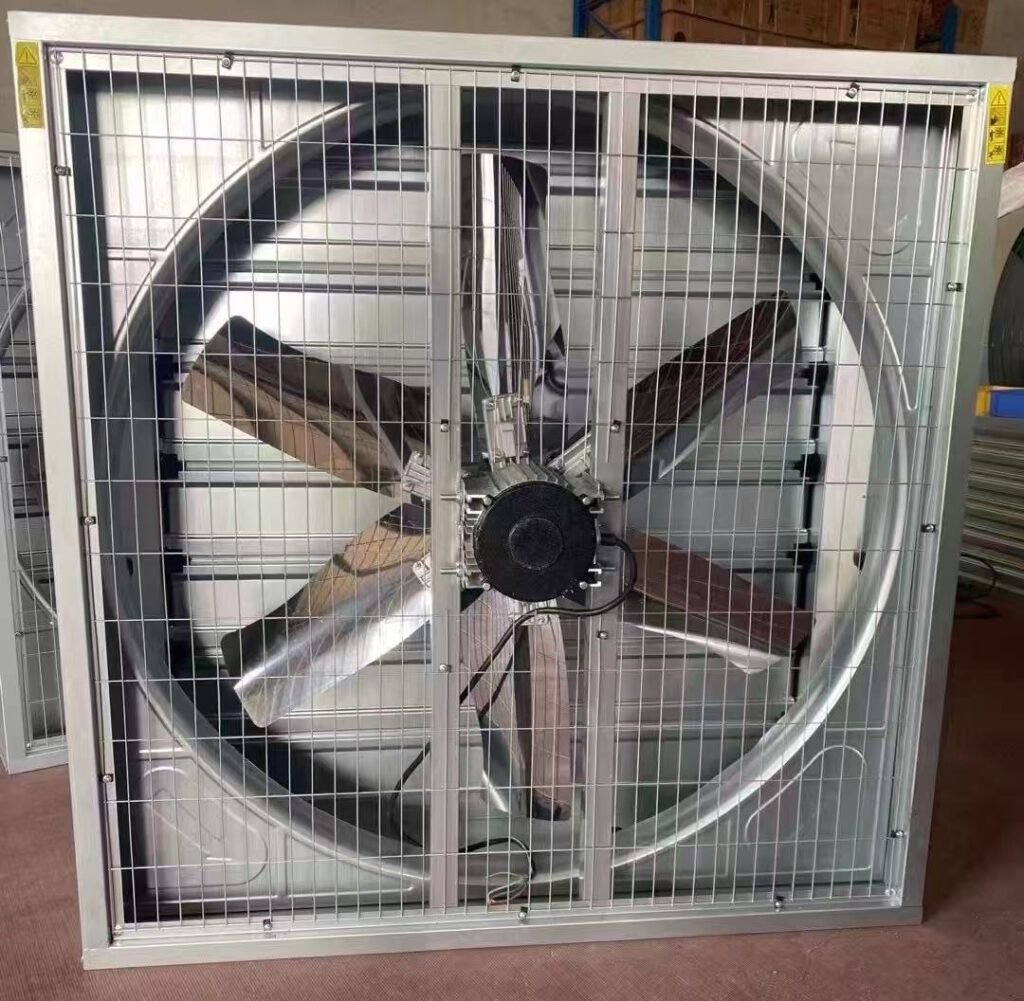Why Exhaust Fans Are a Game-Changer for Poultry Farming

In poultry farming, creating the perfect environment for your birds is key to their health, growth, and productivity. A critical component in achieving this is the exhaust fan, which ensures proper ventilation, temperature control, and air quality in poultry houses. This blog dives into the importance of exhaust fans, their types, features to look for, and practical tips to choose and maintain them for your farm.
The Vital Role of Exhaust Fans in Poultry Houses
Poultry houses are enclosed spaces where heat, moisture, and gases like ammonia (from manure) can quickly build up. Poor ventilation can lead to heat stress, respiratory issues, and reduced egg or meat production. Exhaust fans solve these problems by:
- Ensuring Clean Air: Fans remove dust, harmful gases, and pathogens, replacing stale air with fresh air to prevent diseases like avian influenza or bronchitis.
- Regulating Temperature: By expelling hot air, fans maintain ideal temperatures (18–24°C or 65–75°F for most poultry), preventing heat stress, especially in warmer climates.
- Managing Humidity: Excess moisture causes wet litter and mold, leading to health issues like footpad dermatitis. Fans keep humidity levels at 50–70% for a dry, comfortable environment.
- Boosting Efficiency: A well-ventilated house improves feed conversion, egg production, and growth rates, directly impacting your farm’s profitability.
Types of Exhaust Fans for Poultry Farming
Different poultry farms have unique ventilation needs based on size, bird type, and climate. Here are the main types of exhaust fans:
1. Axial Fans
- Overview: These fans move large volumes of air parallel to the fan’s axis, ideal for low-pressure environments.
- Best For: Small to medium poultry houses with straightforward ventilation needs.
- Example: A 36-inch axial fan can provide 15,000 CFM, suitable for a house with 300–400 birds.
2. Centrifugal Fans
- Overview: Built for high static pressure, these fans are effective in setups with filters, ducts, or light traps.
- Best For: Farms with complex ventilation systems or high resistance.
- Advantage: Maintains performance in challenging conditions.
3. Cone Exhaust Fans
- Overview: Featuring a cone-shaped outlet, these fans maximize airflow and efficiency, often with durable materials like galvanized steel or fiberglass.
- Best For: Large-scale farms in humid or dusty environments.
- Example: A 54-inch cone fan can deliver 28,000 CFM, with up to 20% better efficiency than standard fans.
4. Variable Speed Fans
- Overview: These fans use variable frequency drives (VFDs) to adjust airflow based on real-time conditions, saving energy.
- Best For: Farms with automated climate control systems aiming to reduce electricity costs.
- Consideration: Requires a compatible controller for optimal performance.
What to Look for in Poultry Exhaust Fans
When choosing an exhaust fan, focus on these features to ensure it meets your farm’s needs:
- Airflow Capacity (CFM): Select a fan with enough cubic feet per minute (CFM) for your house size. Aim for 1–2 CFM per bird or 1 CFM per 4 square feet of floor space.
- Energy Efficiency: Choose fans with high CFM/watt ratings (e.g., 18–22 CFM/watt) to lower energy bills. Energy-efficient models can save up to 25% on electricity.
- Build Quality: Opt for corrosion-resistant materials like stainless steel or fiberglass to withstand ammonia and moisture.
- Ease of Maintenance: Look for fans with removable shutters, self-lubricating bearings, or easy-to-clean designs to simplify upkeep.
- Shutter Mechanism: Butterfly or centrifugal shutters minimize air leakage and improve hygiene.
Benefits of High-Quality Exhaust Fans
Investing in reliable exhaust fans delivers significant advantages:
- Healthier Birds: Proper ventilation reduces respiratory diseases and heat stress, lowering mortality rates by up to 5–10%.
- Improved Litter Conditions: Controlled humidity prevents wet litter, reducing the risk of infections and improving bird comfort.
- Cost Savings: Energy-efficient fans cut electricity costs, while durable designs reduce repair and replacement expenses.
- Higher Yields: Better air quality and temperature control lead to improved egg production and faster weight gain, boosting profits.
Maintenance Tips to Keep Fans Running Smoothly
Regular maintenance extends the life of your exhaust fans and ensures optimal performance:
- Clean Regularly: Remove dust, feathers, and litter from blades and shutters every 2–4 weeks to maintain airflow.
- Check Components: Inspect belts, bearings, and blades for wear. Replace damaged parts to prevent breakdowns.
- Lubricate Motors: Apply grease to bearings and motors as per the manufacturer’s guidelines to reduce friction.
- Test Electrical Systems: Ensure connections are secure to avoid power issues, especially for three-phase fans.
- Monitor with Sensors: Use climate controllers to track temperature, humidity, and ammonia levels, adjusting fan speed as needed.
How to Choose the Perfect Exhaust Fan
To find the right exhaust fan for your poultry farm:
- Assess Ventilation Needs: Calculate required CFM based on bird numbers and house dimensions (e.g., 500 birds may need 1,000–1,500 CFM).
- Factor in Climate: In hot or humid areas, prioritize high-CFM cone fans or variable speed models for effective cooling.
- Balance Cost and Quality: While budget-friendly fans are tempting, energy-efficient models offer long-term savings.
- Get Professional Input: Consult with ventilation experts or fan suppliers to match fans with your air inlets, controllers, and house design.
Troubleshooting Common Fan Issues
If your exhaust fans aren’t performing well, try these fixes:
- Low Airflow: Clean clogged shutters or blades. Check for obstructions in air inlets.
- Fan Won’t Start: Inspect wiring, fuses, or the motor. Replace faulty components.
- Loud Operation: Tighten loose parts or lubricate bearings. Replace warped blades to reduce noise.
Conclusion
Exhaust fans are essential for maintaining a healthy and productive poultry farming operation. By choosing the right fan type, prioritizing efficiency and durability, and committing to regular maintenance, you can create an optimal environment for your birds, reduce costs, and increase profits. Whether you’re managing a small backyard flock or a large commercial farm, the right exhaust fan can make all the difference.
Ready to transform your poultry house ventilation? Browse our selection of top-tier exhaust fans or reach out for expert guidance tailored to your farm’s needs!

